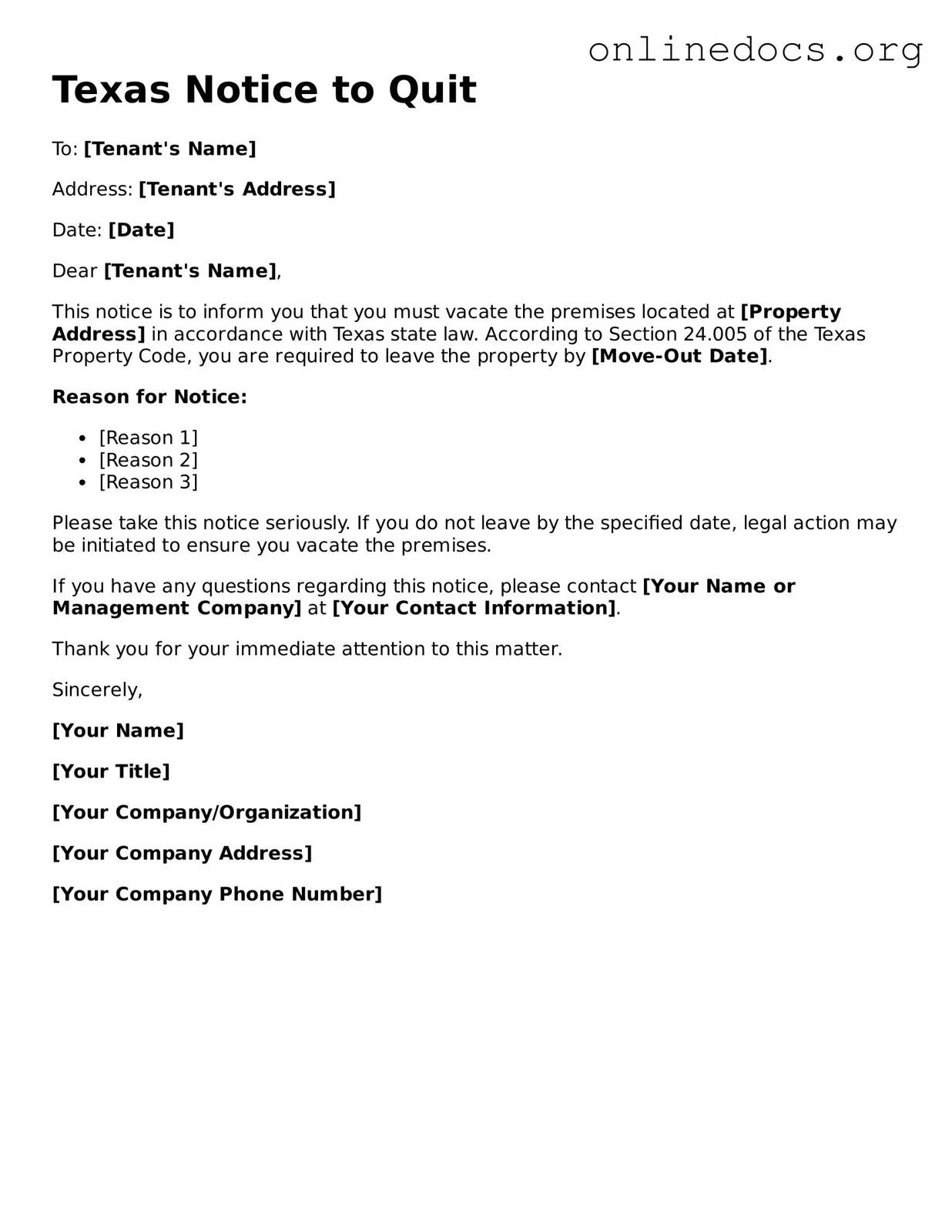The Texas Notice to Quit form shares similarities with the Eviction Notice, which is commonly used in various states. Both documents serve as a formal request for tenants to vacate the premises. The Eviction Notice typically outlines the reasons for the eviction, such as non-payment of rent or lease violations. Like the Texas Notice to Quit, it provides a specified timeframe within which the tenant must leave, ensuring clarity in the communication process.
Another document akin to the Texas Notice to Quit is the Lease Termination Letter. This letter is used by landlords to inform tenants that their lease agreement will not be renewed at the end of the term. Both documents emphasize the necessity for tenants to vacate the property, although the Lease Termination Letter may not always cite specific reasons for termination. The timeframe for vacating is also clearly stated in both instances, allowing tenants to prepare accordingly.
The 3-Day Notice to Pay Rent or Quit is another document that resembles the Texas Notice to Quit. This notice specifically addresses situations where tenants have failed to pay rent on time. It demands payment within three days or the tenant must vacate the property. Similar to the Texas Notice to Quit, it serves as a formal warning and outlines the consequences of non-compliance, reinforcing the landlord's rights in the rental agreement.
The Notice of Non-Renewal is also comparable to the Texas Notice to Quit. This document is used to inform tenants that their lease will not be renewed at the expiration of the current term. While the Texas Notice to Quit may focus on immediate vacating due to specific issues, the Notice of Non-Renewal allows for a more extended timeline, giving tenants notice well in advance of their lease ending.
The Cure or Quit Notice is another document that aligns with the Texas Notice to Quit. This notice is issued when a tenant violates a lease term, giving them a chance to remedy the situation within a specified period. If the tenant fails to comply, they must vacate the property. Both documents aim to protect the landlord's interests while providing the tenant with an opportunity to correct their actions.
The Notice to Vacate is a general document similar to the Texas Notice to Quit. It can be used for various reasons, including lease violations or simply ending a tenancy. Like the Texas Notice to Quit, it informs the tenant of the requirement to vacate the property and usually includes a deadline for doing so. This document ensures that both parties are aware of the expectations and timelines involved.
The Demand for Possession is another related document that conveys a landlord's intent to regain possession of the property. It is often used after a tenant has been served with an eviction notice but has not vacated. Similar to the Texas Notice to Quit, it clearly states the landlord's demand for the tenant to leave, reinforcing the urgency of the situation.
To facilitate the hiring process, it is advisable to complete a detailed Employment Verification form that offers a clear understanding of an applicant's employment history. For more information, you can visit the Employment Verification template resource.
The Notice of Default is also similar to the Texas Notice to Quit. This document is often used in the context of mortgage agreements but can apply to rental agreements as well. It notifies the tenant of their failure to meet specific obligations, such as rent payments. Both documents aim to prompt a response from the tenant, whether it be to remedy the situation or vacate the property.
The Termination of Tenancy Notice can also be compared to the Texas Notice to Quit. This notice is used to terminate a rental agreement, often without cause, and provides the tenant with a specified time to vacate. While the Texas Notice to Quit may be more focused on lease violations, both documents serve the purpose of formally ending a tenancy and ensuring that tenants are aware of their obligations.
Finally, the Final Notice of Eviction is a document that closely mirrors the Texas Notice to Quit. This notice is typically issued when a tenant has ignored previous notices and must vacate the premises immediately. It emphasizes the urgency of the situation and outlines the next steps, similar to the Texas Notice to Quit, which also communicates the necessity for the tenant to leave the property.
